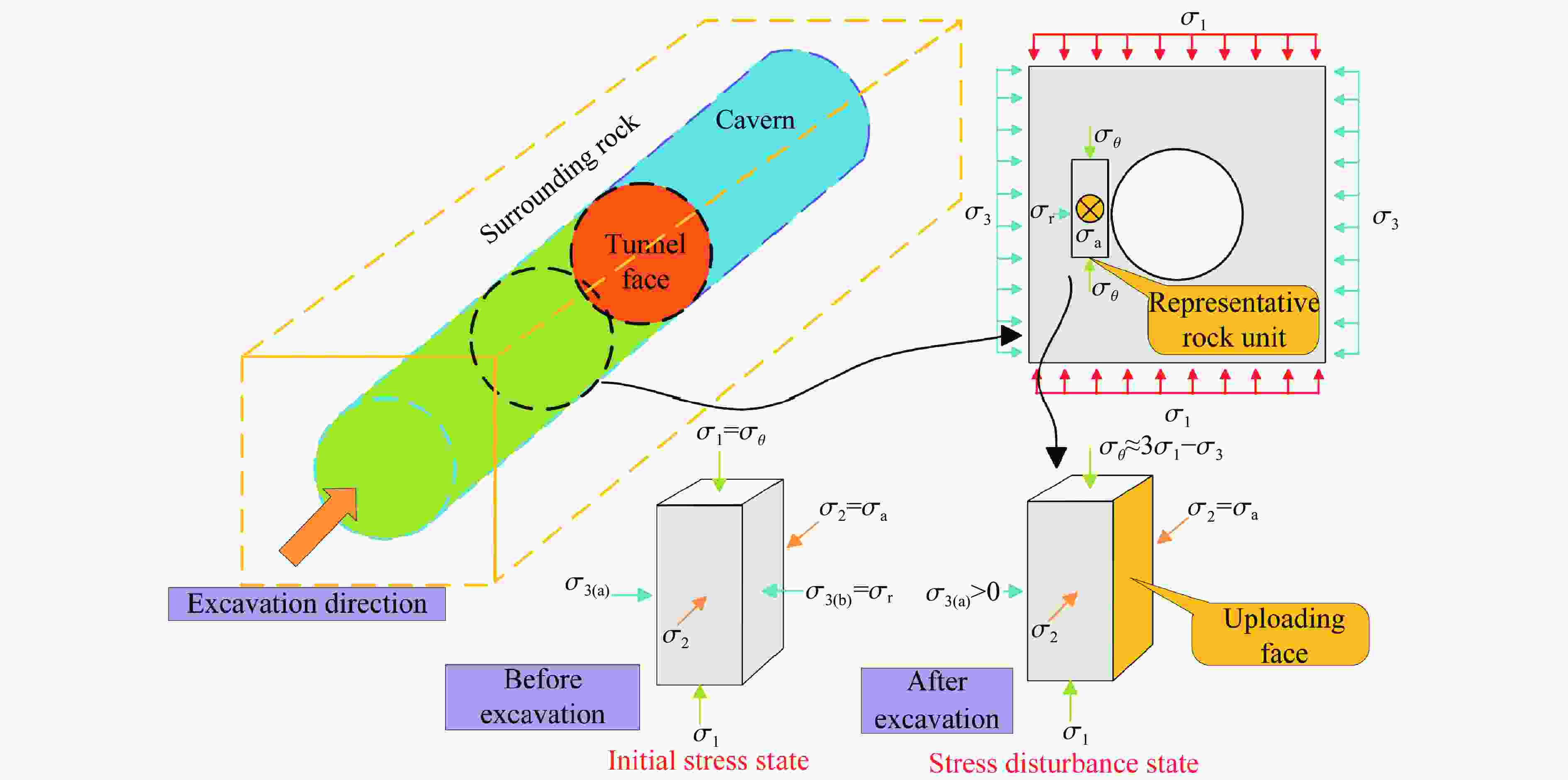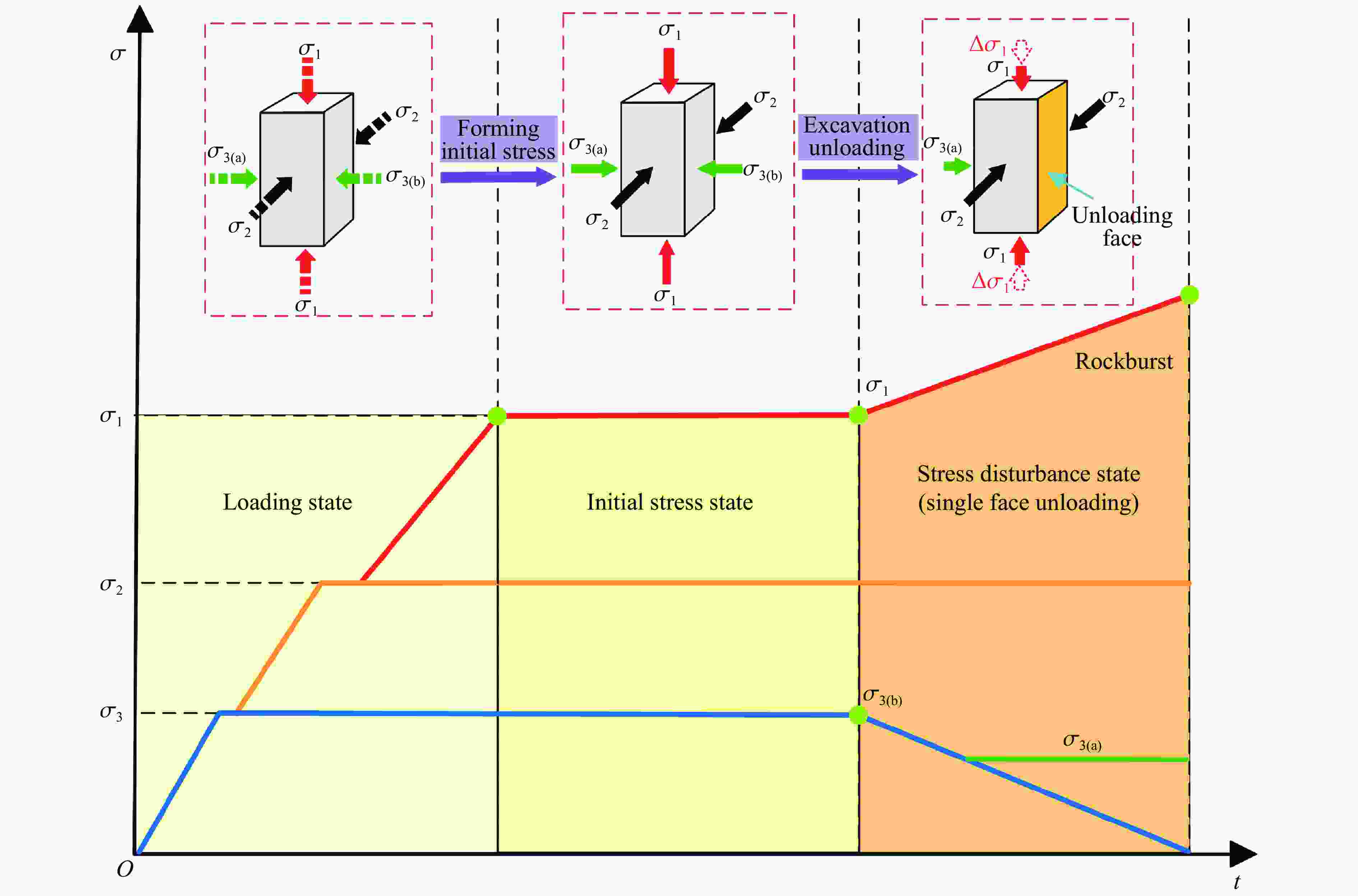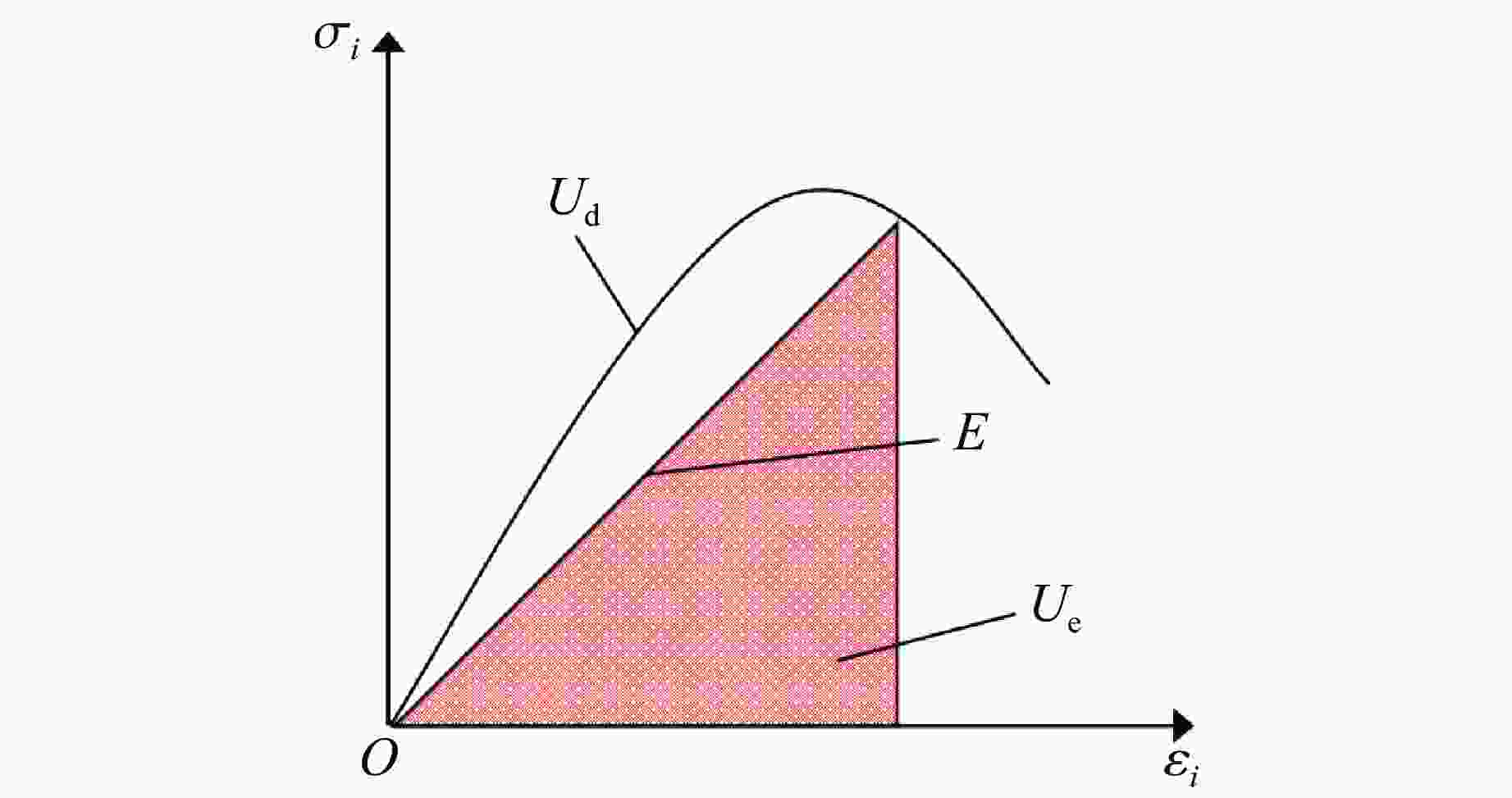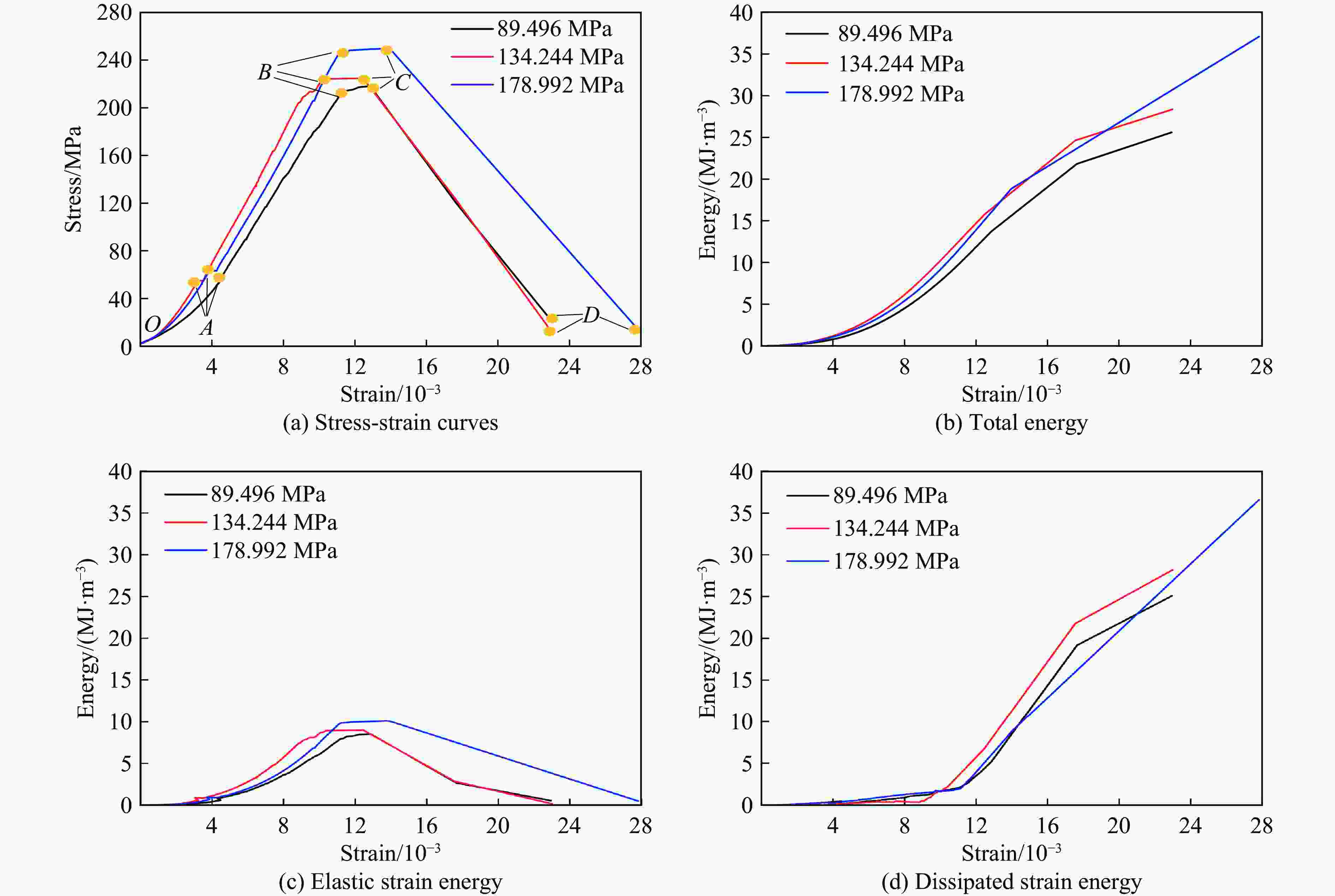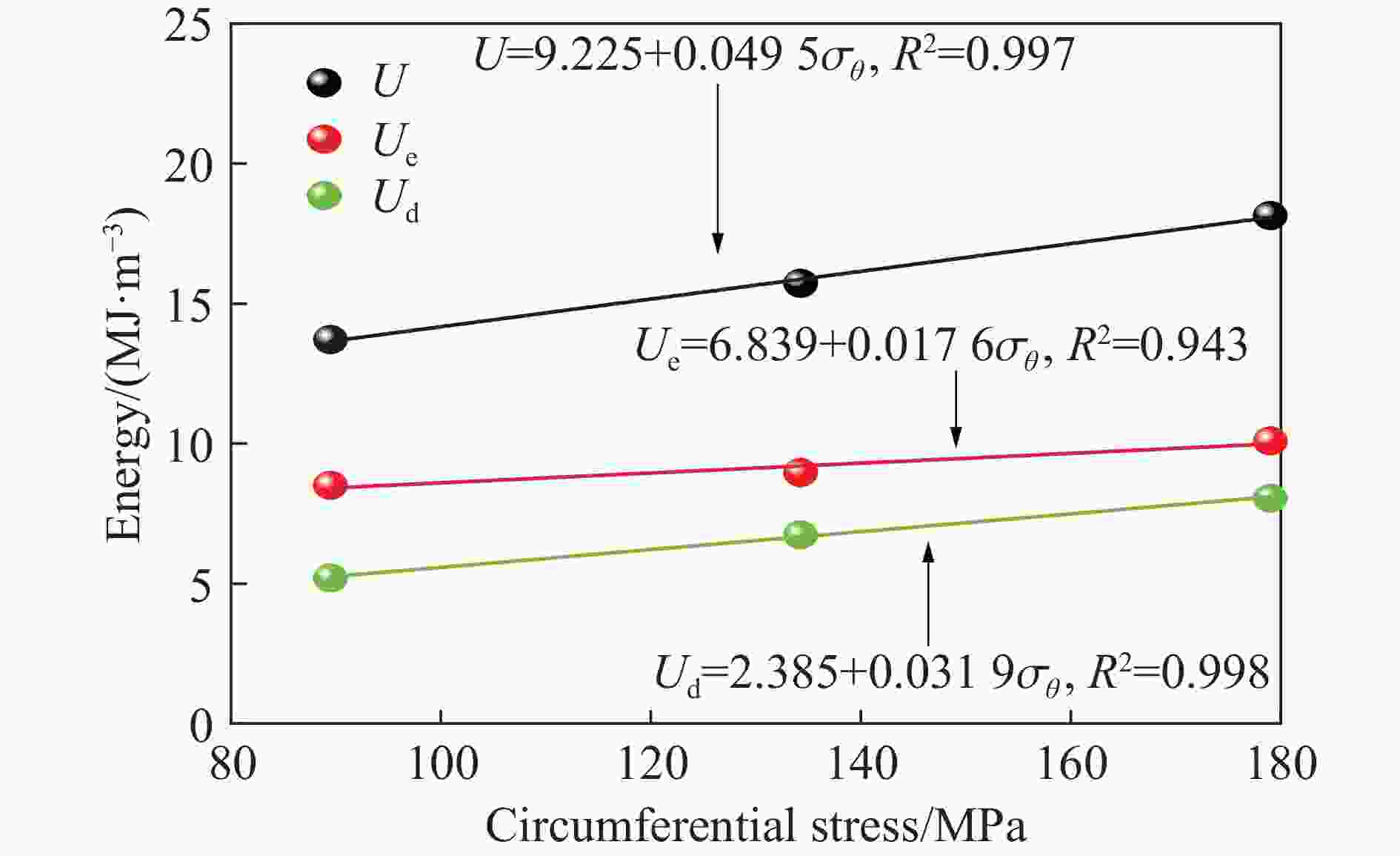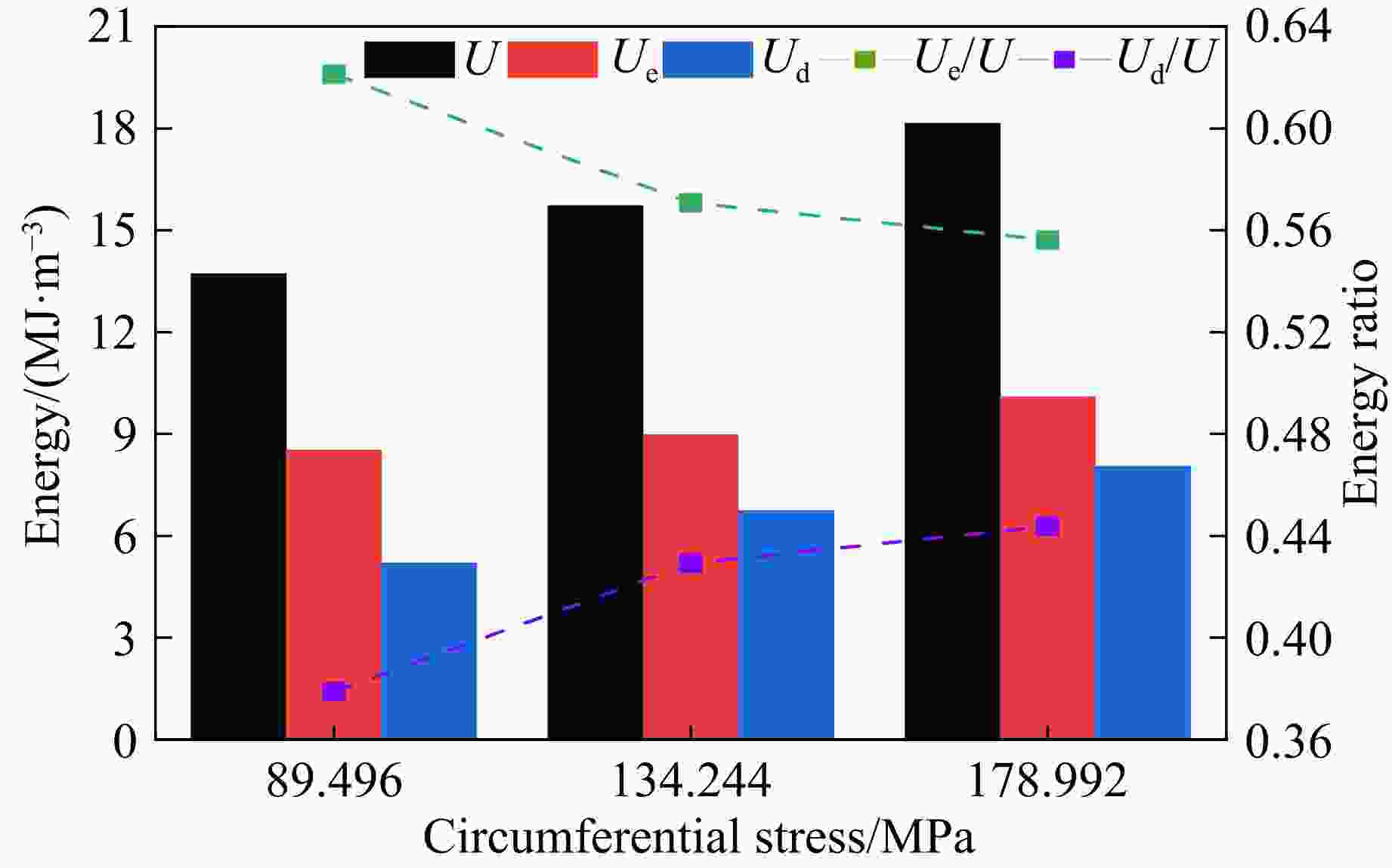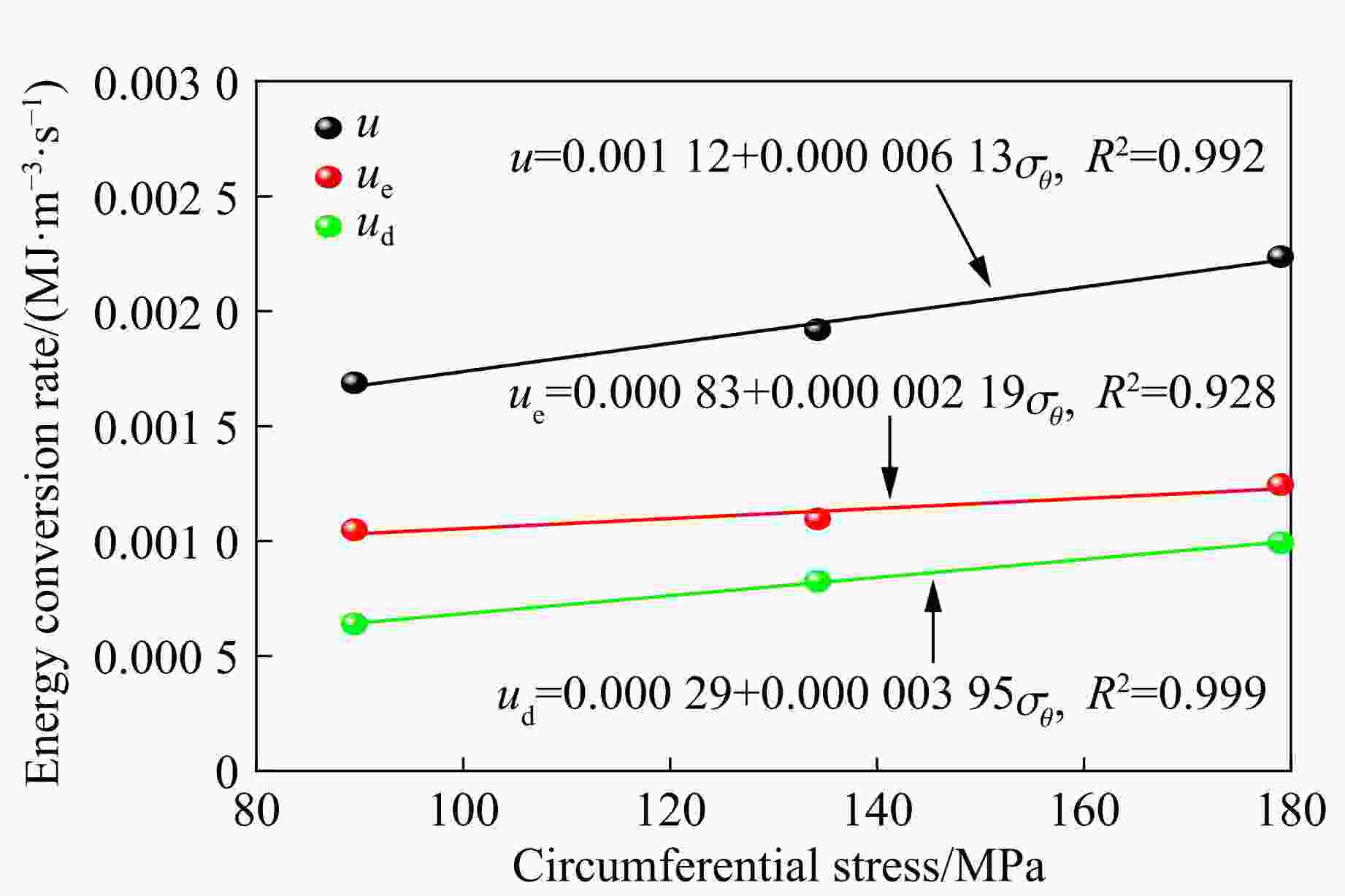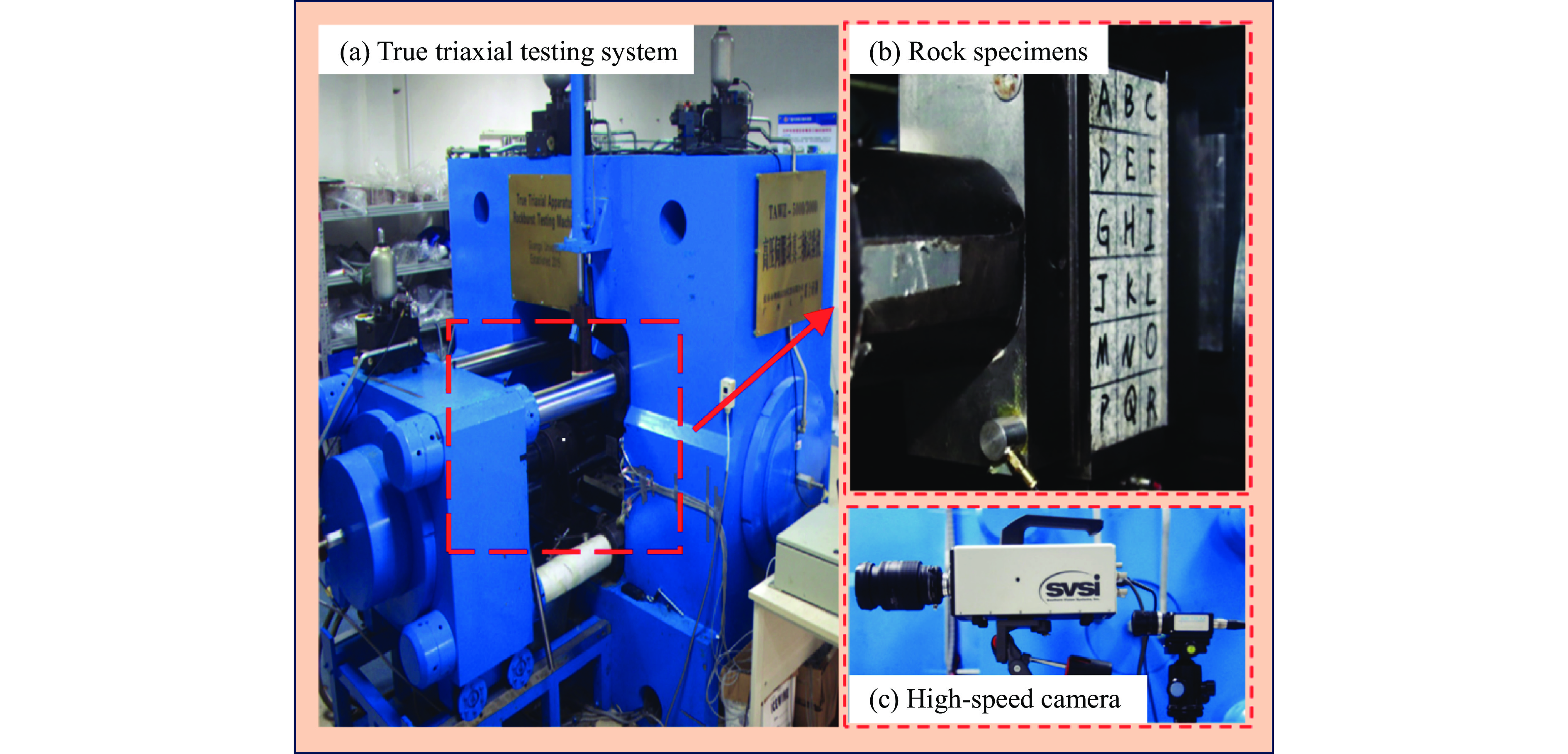Effect of Circumferential Stress on Energy Evolution Mechanism of Rockburst under True Triaxial Unilateral Unloading Conditions
-
摘要: 为研究环向应力对应变型岩爆灾变过程中能量演化的影响,采用新型真三轴岩爆试验系统,开展不同环向应力作用下单面快速卸荷、三向五面受力和竖向持续加载岩爆模拟试验,分析了花岗岩试样在不同环向应力下的岩爆破坏形态,结合能量守恒原理,揭示了试样岩爆灾变过程中各能量的演化规律。结果表明:不同环向应力作用下,耗散能与弹性应变能存在明显的能量竞争演化机制;环向应力会显著影响岩样的破坏程度和分布范围,环向应力为178.992 MPa的岩样卸荷面所形成的破坏程度最深;在高环向应力作用下,岩样内的弹性应变能在峰值点后释放速度加快,岩爆发展具有短时特征;耗散能转化率与环向应力成正比,弹性应变能转化率与环向应力成反比,而从能量的绝对值来看,环向应力的增大会显著提升弹性应变能的累积和耗散能的释放;岩样的总能量转化率最高,弹性能转化率次之,耗散能转化率最低,且三者与环向应力均呈正相关,环向应力的增大会明显加快总能量、弹性应变能及耗散能的转化速率。Abstract: In order to study the influence of hoop stress on the energy evolution in the process of rockburst catastrophe, a new true triaxial rockburst test system was used to carry out the rockburst simulation test of single-side rapid unloading, three-five-side force and vertical continuous loading under different circumferential stresses. The rockburst failure modes of granite samples under different hoop stresses were analyzed. Combined with the principle of energy conservation, the evolution law of individual energy in the process of rockburst catastrophe was revealed. The results show that there is an obvious energy competition evolution mechanism between dissipated energy and elastic strain energy under different circumferential stresses. The circumferential stress will significantly affect the damage degree and distribution range of the rock sample. The unloading surface of the rock sample with a circumferential stress of 178.992 MPa has the deepest damage degree. Under the action of high circumferential stress, the elastic strain energy in the rock sample releases faster after the peak point, and the development of rockburst has short-term characteristics. The conversion rate of dissipated energy is proportional to the circumferential stress, and the conversion rate of elastic strain energy is inversely proportional to the circumferential stress. From the absolute value of energy, the increase of circumferential stress will obviously increase the accumulation of elastic strain energy and the release of dissipated energy. The total energy conversion rate of the rock sample is greater than the elastic energy conversion rate, which in turn exceeds the dissipated energy conversion rate. All three parameters exhibit positive correlations with circumferential stress. The increase of the circumferential stress will obviously accelerate the conversion rates of total energy, elastic energy and dissipated energy.
-
表 1 试验方案
Table 1. Test protocol
Research project Specimen No. Stress state/MPa σ1 σ2 σ3(a) Circumferential stress T-1 89.496 54.966 5.000 T-2 134.244 54.966 5.000 T-3 178.992 54.966 5.000 -
[1] HE S Y, LAI J X, ZHONG Y J, et al. Damage behaviors, prediction methods and prevention methods of rockburst in 13 deep traffic tunnels in China [J]. Engineering Failure Analysis, 2021, 121: 105178. doi: 10.1016/j.engfailanal.2020.105178 [2] ZHANG C Q, FENG X T, ZHOU H, et al. Case histories of four extremely intense rockbursts in deep tunnels [J]. Rock Mechanics and Rock Engineering, 2012, 45(3): 275–288. doi: 10.1007/s00603-011-0218-6 [3] ZHANG G H, JIAO Y Y, WANG H. Outstanding issues in excavation of deep and long rock tunnels: a case study [J]. Canadian Geotechnical Journal, 2014, 51(9): 984–994. doi: 10.1139/cgj-2013-0087 [4] 郭佳奇, 毋文涛, 颜天佑, 等. 爆破开挖扰动下深埋隧洞围岩含水裂隙起裂机制研究 [J]. 岩石力学与工程学报, 2024, 43(Suppl 2): 3597–3608. doi: 10.13722/j.cnki.jrme.2023.0367GUO J Q, WU W T, YAN T Y, et al. Study on crack initiation mechanism of water-bearing fractures in surrounding rock mass of deep-buried tunnel under blasting excavation disturbance [J]. Chinese Journal of Rock Mechanics and Engineering, 2024, 43(Suppl 2): 3597–3608. doi: 10.13722/j.cnki.jrme.2023.0367 [5] KONICEK P, SCHREIBER J. Heavy rockbursts due to longwall mining near protective pillars: a case study [J]. International Journal of Mining Science and Technology, 2018, 28(5): 799–805. doi: 10.1016/j.ijmst.2018.08.010 [6] FENG G L, FENG X T, CHEN B R, et al. Microseismic sequences associated with rockbursts in the tunnels of the Jinping Ⅱ hydropower station [J]. International Journal of Rock Mechanics and Mining Sciences, 2015, 80: 89–100. doi: 10.1016/j.ijrmms.2015.06.011 [7] DRIAD-LEBEAU L, LAHAIE F, AL HEIB M, et al. Seismic and geotechnical investigations following a rockburst in a complex French mining district [J]. International Journal of Coal Geology, 2005, 64(1/2): 66–78. doi: 10.1016/j.coal.2005.03.017 [8] HU L H, LIANG X, LIANG Z Z, et al. Influence of radial stress on strainbursts under true triaxial conditions: insights from a distinct element modelling [J]. International Journal of Rock Mechanics and Mining Sciences, 2021, 138: 104577. doi: 10.1016/j.ijrmms.2020.104577 [9] SONG Z L, YIN G Z, RANJITH P G, et al. Influence of the intermediate principal stress on sandstone failure [J]. Rock Mechanics and Rock Engineering, 2019, 52(9): 3033–3046. doi: 10.1007/s00603-019-01756-1 [10] COOK N G W. The basic mechanics of rockbursts [J]. Journal of the Southern African Institute of Mining and Metallurgy, 1963, 64(3): 71–81. [11] LUO S, GONG F Q, PENG K, et al. Rockburst proneness considering energy characteristics and sample shape effects [J]. Journal of Rock Mechanics and Geotechnical Engineering, 2024, 16(7): 2441–2465. doi: 10.1016/j.jrmge.2023.09.003 [12] MANOUCHEHRIAN A, CAI M. Simulation of unstable rock failure under unloading conditions [J]. Canadian Geotechnical Journal, 2016, 53(1): 22–34. doi: 10.1139/cgj-2015-0126 [13] CAI X, CHENG C Q, ZHOU Z L, et al. Rock mass watering for rock-burst prevention: some thoughts on the mechanisms deduced from laboratory results [J]. Bulletin of Engineering Geology and the Environment, 2021, 80(11): 8725–8743. doi: 10.1007/s10064-021-02467-0 [14] ZHAO H G, LIU C, HUANG G, et al. Experimental investigation on rockburst process and failure characteristics in trapezoidal tunnel under different lateral stresses [J]. Construction and Building Materials, 2020, 259: 119530. doi: 10.1016/j.conbuildmat.2020.119530 [15] LU Y S, LI P F, CAI W. Experimental study on the evolutionary characteristics of acoustic signals produced by granite under biaxial compression with different intermediate principal stresses [J]. Frontiers in Earth Science, 2023, 11: 1271355. doi: 10.3389/feart.2023.1271355 [16] LUO D N, XIE Y Q, LU S H, et al. Experimental study on the effects of water saturation on the microseismic and acoustic emission characteristics of sandstone in different stress states [J]. Rock Mechanics and Rock Engineering, 2022, 55(11): 6583–6603. doi: 10.1007/s00603-022-03001-8 [17] ZHAO H G, DENG B Z, HUANG G, et al. Influence of principal stress orientation on stress distribution and plastic zone evolution of rock surrounding tunnels [J]. Physics of Fluids, 2024, 36(2): 027123. doi: 10.1063/5.0187253 [18] TANG J B, LI S, QIN G S, et al. Experiments on mechanical response and energy dissipation behavior of rockburst-prone coal samples under impact loading [J]. Shock and Vibration, 2021, 2021(1): 9924456. doi: 10.1155/2021/9924456 [19] HUANG L Q, SI X F, LI X B, et al. Influence of maximum principal stress direction on the failure process and characteristics of D-shaped tunnels [J]. International Journal of Mining Science and Technology, 2022, 32(5): 1125–1143. doi: 10.1016/j.ijmst.2022.07.004 [20] WANG G, LIU X Q, SONG L B, et al. Fracture evolution characteristics of strainburst under different gradient stress [J]. International Journal for Numerical and Analytical Methods in Geomechanics, 2023, 47(18): 3381–3398. doi: 10.1002/nag.3627 [21] LIU X Q, XIA Y Y, LIN M Q, et al. Experimental study on the influence of tangential stress gradient on the energy evolution of strainburst [J]. Bulletin of Engineering Geology and the Environment, 2021, 80(6): 4515–4528. doi: 10.1007/s10064-021-02244-z [22] 孙飞跃, 郭佳奇, 张小兵, 等. 真三轴单面卸荷条件下隧道岩爆特征的径向应力梯度效应研究 [J]. 岩石力学与工程学报, 2025, 44(2): 373–390. doi: 10.3724/1000-6915.jrme.2024.0604SUN F Y, GUO J Q, ZHANG X B, et al. Research on the radial stress gradient effect of rockburst characteristics in tunnel under true triaxial condition with single-side unloading [J]. Chinese Journal of Rock Mechanics and Engineering, 2025, 44(2): 373–390. doi: 10.3724/1000-6915.jrme.2024.0604 [23] HU L H, YU L Y, JU M H, et al. Effects of intermediate stress on deep rock strainbursts under true triaxial stresses [J]. Journal of Rock Mechanics and Geotechnical Engineering, 2023, 15(3): 659–682. doi: 10.1016/J.JRMGE.2022.06.008 [24] CAI M. Influence of intermediate principal stress on rock fracturing and strength near excavation boundaries—insight from numerical modeling [J]. International Journal of Rock Mechanics and Mining Sciences, 2008, 45(5): 763–772. doi: 10.1016/j.ijrmms.2007.07.026 [25] CHEN Z Y, SU G S, JU J W, et al. Experimental study on energy dissipation of fragments during rockburst [J]. Bulletin of Engineering Geology and the Environment, 2019, 78(7): 5369–5386. doi: 10.1007/s10064-019-01463-9 [26] SU G S, FENG X T, WANG J H, et al. Experimental study of remotely triggered rockburst induced by a tunnel axial dynamic disturbance under true-triaxial conditions [J]. Rock Mechanics and Rock Engineering, 2017, 50(8): 2207–2226. doi: 10.1007/s00603-017-1218-y [27] 钱七虎. 岩爆、冲击地压的定义、机制、分类及其定量预测模型 [J]. 岩土力学, 2014, 35(1): 1–6. doi: 10.16285/j.rsm.2014.01.028QIAN Q H. Definition, mechanism, classification and quantitative forecast model for rockburst and pressure bump [J]. Rock and Soil Mechanics, 2014, 35(1): 1–6. doi: 10.16285/j.rsm.2014.01.028 [28] 田朝阳, 兰恒星, 张宁, 等. 某交通线路色季拉山隧道高地应力岩爆风险定量预测研究 [J]. 工程地质学报, 2022, 30(3): 621–634. doi: 10.13544/j.cnki.jeg.2022-0113TIAN C Y, LAN H X, ZHANG N, et al. Quantitative prediction of rockburst risk in Sejila Tunel of one railway [J]. Journal of Engineering Geology, 2022, 30(3): 621–634. doi: 10.13544/j.cnki.jeg.2022-0113 [29] 王长柏, 李海波, 谢冰, 等. 岩体爆破裂纹扩展影响因素分析 [J]. 煤炭科学技术, 2010, 38(10): 31–34, 61. doi: 10.13199/j.cst.2010.10.38.wangzhb.036WANG C B, LI H B, XIE B, et al. Analysis on influencing factors of blasting crack expansion [J]. Coal Science and Technology, 2010, 38(10): 31–34, 61. doi: 10.13199/j.cst.2010.10.38.wangzhb.036 [30] 苏国韶, 陈智勇, 蒋剑青, 等. 不同加载速率下岩爆碎块耗能特征试验研究 [J]. 岩土工程学报, 2016, 38(8): 1481–1489. doi: 10.11779/CJGE201608016SU G S, CHEN Z Y, JIANG J Q, et al. Experimental study on energy dissipating characteristics of rockburst fragments under different loading rates [J]. Chinese Journal of Geotechnical Engineering, 2016, 38(8): 1481–1489. doi: 10.11779/CJGE201608016 [31] 罗丹旎, 苏国韶, 何保煜. 不同饱水度花岗岩的真三轴岩爆试验研究 [J]. 岩土力学, 2019, 40(4): 1331–1340. doi: 10.16285/j.rsm.2017.2432LUO D N, SU G S, HE B Y. True triaxial test on rockburst of granites with different water saturations [J]. Rock and Soil Mechanics, 2019, 40(4): 1331–1340. doi: 10.16285/j.rsm.2017.2432 [32] SU G S, JIANG J Q, FENG X T, et al. Influence of loading rate on strainburst: an experimental study [J]. Bulletin of Engineering Geology and the Environment, 2019, 78(5): 3559–3573. doi: 10.1007/s10064-018-1351-1 [33] GONG F Q, DAI J H, XU L. A strength-stress coupling criterion for rockburst: inspirations from 1114 rockburst cases in 197 underground rock projects [J]. Tunnelling and Underground Space Technology, 2023, 142: 105396. doi: 10.1016/j.tust.2023.105396 [34] NIU W J, WEI S, FENG G L, et al. Influence of stress and geology on the most prone time of rockburst in drilling and blasting tunnel: 25 tunnel cases [J]. Engineering Geology, 2024, 340: 107680. doi: 10.1016/j.enggeo.2024.107680 [35] 葛修润, 侯明勋. 三维地应力BWSRM测量新方法及其测井机器人在重大工程中的应用 [J]. 岩石力学与工程学报, 2011, 30(11): 2161–2180.GE X R, HOU M X. A new 3D in-situ rock stress measuring method: borehole wall stress relief method (BWSRM) and development of geostress measuring instrument based on BWSRM and its primary applications to engineering [J]. Chinese Journal of Rock Mechanics and Engineering, 2011, 30(11): 2161–2180. [36] 郭佳奇, 程立攀, 朱斌忠, 等. 持续开挖效应下结构面剪切力学性质与能量特征研究 [J]. 岩土力学, 2023, 44(1): 131–143. doi: 10.16285/j.rsm.2022.0391GUO J Q, CHENG L P, ZHU B Z, et al. Shear mechanical properties and energy characteristics of rock joints under continuous excavation effect [J]. Rock and Soil Mechanics, 2023, 44(1): 131–143. doi: 10.16285/j.rsm.2022.0391 [37] 张志镇, 高峰. 3种岩石能量演化特征的试验研究 [J]. 中国矿业大学学报, 2015, 44(3): 416–422. doi: 10.13247/j.cnki.jcumt.000321ZHANG Z Z, GAO F. Experimental investigations on energy evolution characteristics of coal, sandstone and granite during loading process [J]. Journal of China University of Mining & Technology, 2015, 44(3): 416–422. doi: 10.13247/j.cnki.jcumt.000321 -






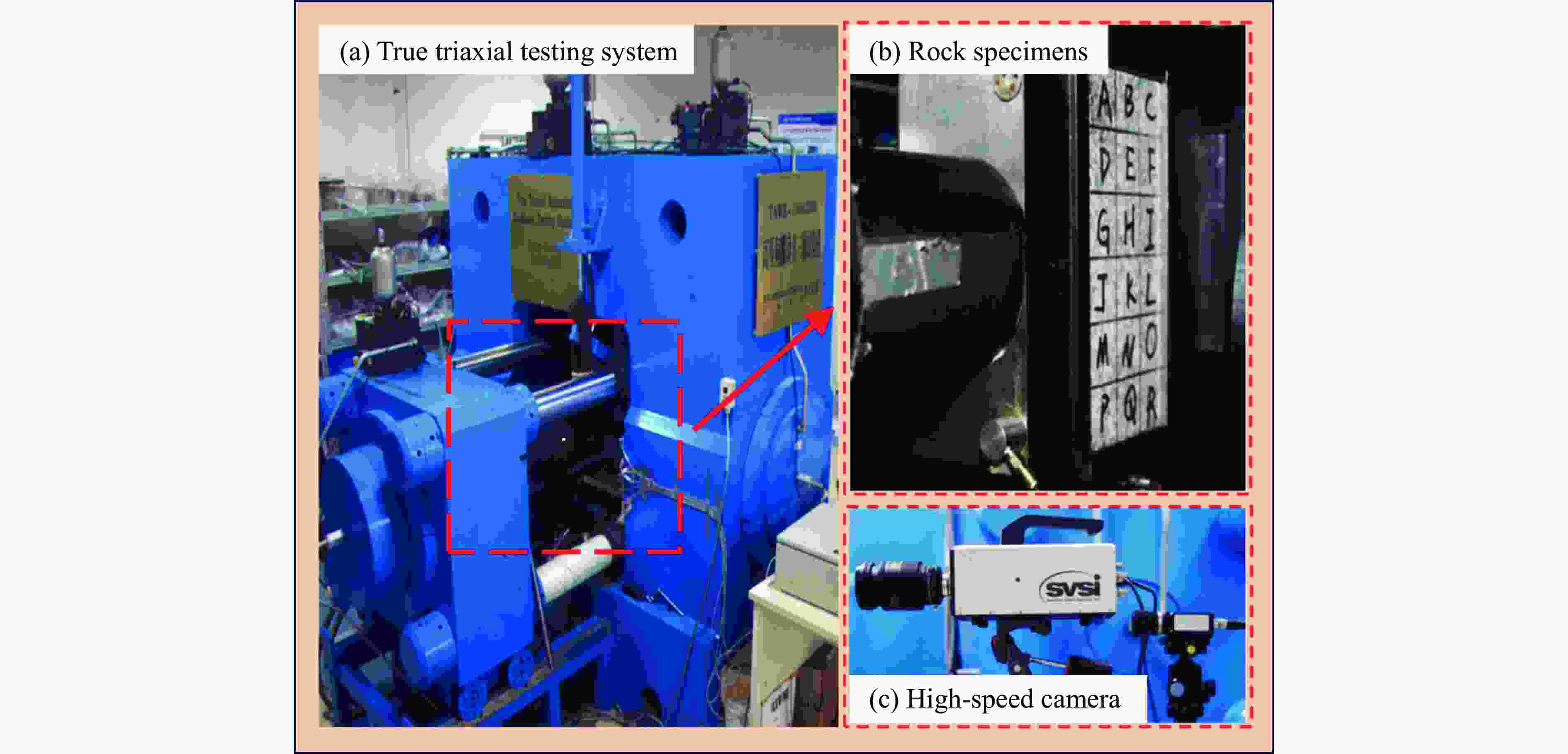
 下载:
下载:

